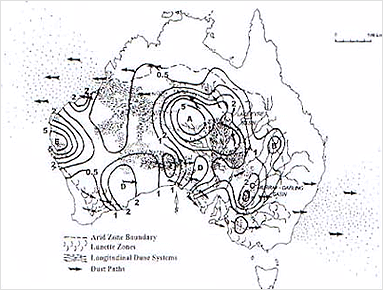
Home > Weather > Typhoon / Asia Dust > Asia Dust > World Atlas


Annual frequency of dust storms in Australia, from analysis of meteorological data for the period of 1960 - 1984. FIve regions of the continent have high dust storm frequencies;
Dust storm activity is largely confined to the semi-arid and arid regions with annual rainfall less than 400mm
(modified from McTrainsh and Pitblado,1987)
Wind erosion as a geological process has been occurring in Australia for millions of years. The clearance of native vegetation and intensive farming and grazing in the past 200 years have contributed to increased wind-erosion activities in some areas. Most of the recent severe wind-erosion events are observed in the agricultural areas of southern Australia. It has been found that Australia has six regions with high dust-storm frequencies: namely central Australia(A), central Queensland(B), the Mallee region(C), the eastern and western Nullarbor region(D) and coastal Western Australian(E). Dust storm activities are largely confined to the semi-arid and arid regions with an annual rainfall less than 400 mm. Dust storms occur most frequently in central Australia and coastal Western Australia. Dust transport across the Australian continent follows two major paths: the southeastward path in the westerlies and the northwestward path in the easterlies. Dust particles originating from inland Australia are blown offshore either through one or other of the above paths, depending upon the meteorological situation prevailing at the time.
Wind erosion in Australia is most active during drought years associated with the El Nino phenomenon. The analysis of historical data shows that the eastern parts of Australia suffer under reduced rainfall decreased vegetation cover and increased soil erosion during El Nino events. Frequent high dust concentrations were observed in early 1994 and again in early 1996. The increased dust-storm activities during 1994 and 1996 can be attributed to the prevailing dry conditions in these two years. In southern Australia, sind-erosion events are prevalent during summer. Dust-storm frequency is highest in January, February, and March. Dust storms are commonly associated with summer frontal systems advancing from southwest to northeast. These systems often generate warm gusty northwesterly airflows which result in a very dry top soil, followed by strong southwesterly winds, creating an ideal condition for dust storms.
A deep low-pressure system was approaching Australia from the Southern Ocean, accompanied by very strong to gale-force north to northwesterly winds ahead of the front. This was followed by a vigorous cool to cold south to southeasterly air stream which persisted for several days after the frontal passage. The wind speed near the surface was as strong as 20 m/s, causing widespread wind erosion. In the northern regions of Australia, wind-erosion events occur mostly during spring to early summer. Dust-storm frequency is highest in September, October and November. As the northern regions of Australia are influenced by summer rainfall, dust storms peak during September to November, at the end of the dry season, and then decrease with the onset of summer rains. During September to November, winds are also strongest in the northern regions of Australia. The total dust emission from the Australian continent is not yet known, but estimates of annual dust emission are in the order of several million tones. (Shao, 2000)